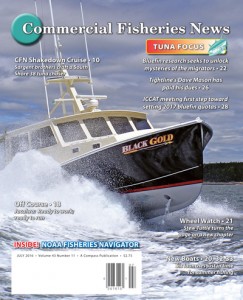Now that draft regional ocean plan is out, fishermen again encouraged to comment and help shape final document
by Amy Trice and Anne Hawkins
In Commercial Fisheries News May issue, the background, impending release, and need for fishermen to comment on the draft Northeast Regional Ocean Plan were discussed.
The Northeast Regional Planning Body (RPB) is now accepting written comments on the draft ocean plan through July 25, and will host a series of public meetings across the region.
A full list of meetings is provided on the RPB’s website. We encourage you to review the ocean plan and provide comments relevant to your fisheries.
On May 25, the RPB – comprised of six New England states, six federally-recognized tribes, nine federal agencies, and the New England Fishery Management Council – released the nation’s first draft Regional Ocean Plan.

by Amy Trice and Anne Hawkins
Over four years in the making, and building on the efforts in the region that have occurred over the last decade, the Regional Ocean Plan (the plan) is intended to advance coastal and ocean data, improve engagement with ocean users, and enhance coordination among agencies who manage ocean and coastal resources.
We urge you to take this opportunity to review the plan, data, and information related to commercial fisheries, and tell the RPB what they have gotten right or wrong, and what data you want improved. Comments will be considered and incorporated into a final version of the plan, which is scheduled for release this coming fall.
The ocean plan describes ten “ocean use sectors” including commercial and recreational fishing.
For the commercial fishing sector, the plan’s introduction characterizes the current economy of commercial fisheries in the Northeast and highlights the benefits the industry brings to the region. It also broadly addresses the dynamic nature of fisheries.
More importantly, it notes that potential offshore developments – ranging from sand and gravel mining projects and offshore energy to routine activities like scientific studies, ship-based seafloor mapping projects, and the dredging of port channels – may result in conflicts with commercial fisheries.
The action items in the plan reference a range of commercial fisheries maps found on the Northeast Ocean Data Portal, which depict the spatial footprint of vessels operating in certain federally-managed fisheries, and the geographic extent of certain federal fishery management areas.
These data are intended to provide a regional perspective for federal and state agencies and potential project developers to give more insight into whether potential activities offshore may impact fisheries.
In the past, these data were not always easily accessible to all agencies or ocean users. The hope is that increasing its accessibility will improve coordination among ocean managers.
Information in the data portal is intended merely to inform project proponents of fisheries that, due to their location, may be affected by a given project. In turn, the agencies then know with whom to consult for more information.
Existing fisheries data will still be used in decision-making. Agencies have committed to use the data and the ocean plan to inform their permitting processes in this way.
Ideally, this will lead those agencies to improve communication with fishermen much earlier than has happened in the past, which will avoid and minimize impacts to fishermen who already face a complex and time-consuming management structure.
Lastly, the ocean plan outlines a regional research and science agenda, which describes work to monitor ocean chemistry changes such as ocean acidification, shifts in fish distribution and abundance, and the resulting impacts to commercial and recreational fisheries.
It also identifies data gaps including the need to improve the characterization of commercial fishing activity in the region for fisheries that do not use Vessel Monitoring Systems (VMS), locally important fisheries, and the effects of changing stock distribution and abundance.
The RPB has stated its goal is to improve coordination among states, tribes, federal agencies, fishery management councils, and affected ocean users like fishermen, when new activities are proposed in the ocean.
It is therefore especially important that fishermen comment on the following: (1) whether the Northeast Ocean Data Portal contains accurate information on your fishery; (2) whether the strategies outlined in the document will, in fact, reduce conflict in offshore permitting processes; (3) the usefulness of the research priorities; and (4) other aspects of the plan you agree or disagree with.
Amy Trice is a policy analyst for Ocean Conservancy. Anne Hawkins is an associate in the Washington, D.C., office of Kelley, Drye & Warren LLP.

To get more great content like this you’ll need the July 2016 issue of Commercial Fisheries News – please choose from the following options:
BUY a Single PRINT edition of CFN that is delivered by MAIL. PRINT EDITION
Quickly enjoy ONLINE access with our Hi-DEF flip-book. PURCHASE ONLINE EDITION
(Read online flip-book immediately with purchased access key and download a copy for yourself to keep. Not sure if it works for you? Try a FREE SAMPLE HERE.)
SAVE BIG when you SUBSCRIBE!






